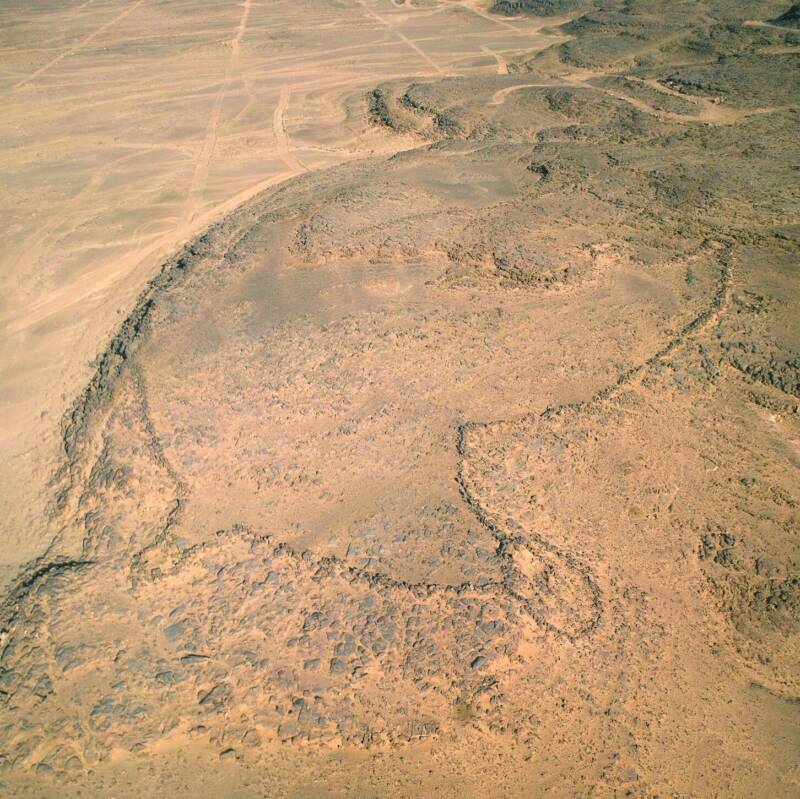Two carved stones in Jordan and Saudi Arabia are etched with accurate to-scale representation of nearby desert kites, which served as a method for hunting herds of wild animals.

SEBAP & Crassard et al., PLOS ONE 2023; O. Barge/CNRSA “blueprint” of a nearby desert kite found on a standing monolith in Jordan.
Roughly 100 years ago, aerial photography captured pictures of large stone structures on the Arabian Peninsula that captivated archaeologists. Known as desert kites, these megastructures stretch for miles, are made up of driving lines and star-shaped enclosures, and loosely resemble their namesake in shape.
Now, researchers have uncovered a pair of engraved stones that appear to depict some of these kites to scale, suggesting that ancient humans had a deep understanding of dimensional space — and may have even drawn up scaled blueprints to help construct the structures.
As The New York Times reports, the purpose of desert kites long eluded researchers, but recent studies provided an answer: the kites were used to trap and kill wild herds of animals. Even with their purpose known, however, archaeologists were puzzled as to how ancient humans conceived the massive structures.
As Rémy Crassard, an archaeologist at the French National Center for Scientific Research, explained, the kites are “only visible from the air” in their entirety.
“Even with our modern ways of envisaging our landscape, it’s still difficult for us archaeologists, scientists, scholars to make a proper map,” he said.
Because of their size, desert kites have historically been difficult to study. For the last decade, Crassard and colleagues with the Globalkites Project have used satellite images to identify more than 6,000 desert kites across large regions of the Middle East and Asia, which has helped the study of large-scale desert kites progress at a far quicker rate.
Then, in 2015, Crassard and colleagues made an invaluable discovery. Near some of these kites were two stones with etchings of stars and lines on them — apparent blueprints for the desert kites, drawn to scale.
Their research, published in the journal PLOS One, shows that the stones were etched between 7,000 and 9,000 years ago, indicating that ancient humans on the Arabian Peninsula had a sophisticated understanding of space. This also marks the earliest known example of to-scale architectural plans in human history.
“It’s mind-blowing to know and to show that they were able to have this mental conceptualization of very large spaces and to put that on a smaller surface,” Crassard said.

O. Barge/CNRS)A satellite image of a kite seen in Saudi Arabia.
Though researchers have found man-made etchings of kites on rocks before, “you couldn’t relate these drawings to a specific kite,” Crassard said. But the two stones in Southeastern Jordan and Northern Saudi Arabia were different.
The Jordan monolith stands about three feet tall, while the Saudi Arabian structure is more than 12 feet tall and nearly eight feet across. Researchers knew they were looking at something truly remarkable when they identified the presence of three features in the etchings definitive of desert kites: a line of stones called the “tail strings” leading to a walled enclosure similar to a kite’s “body,” and pits along the body’s edges.
Crassard and colleagues then compared these etchings with satellite imagery of nearby kites and mathematically compared them through geographical graph modeling. The results were shocking.
“The engravings are surprisingly realistic and accurate, and are moreover to scale, as observed by the geometric graph-based assessment of shape similarity,” they wrote in the study. “These examples of kite representations are thus the oldest known architectural plans to scale in human history.”

R. Crassard/CNRSA Saudi Arabian desert kite as seen from the ground.
“When we look at the satellite and aerial images that we take in the field, it’s like a drawing of the actual kites in this area,” said archaeologist Mohammad Tarawneh, one of the study’s authors.
It remains unknown, however, whether the engravings were actually used as blueprints to pre-plan the kites’ construction, or if they were created after the fact, possibly to be used as maps for hunters.
Another author on the study, Wael Abu-Azizeh, an archaeologist with the French Institute of the Near East in Jordan, also theorized that the engravings could have been symbolic representations of the kites to help preserve them. The kites may have been culturally significant to the ancient humans who constructed them, and the etchings could therefore have been done in commemoration.
Crassard and colleagues are continuing to examine the kites as part of the Globalkites Project.
After reading about these fascinating ancient blueprints, read about the time an archaeology student accidentally stumbled upon the oldest animal carvings in Scotland. Then, read about the ancient rock carvings that may hint at a lost civilization.





